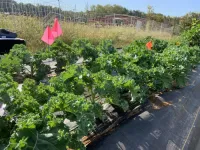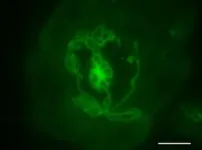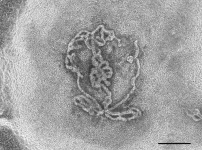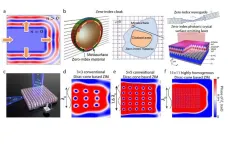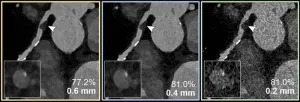(Press-News.org)
Kale fans can rest easy knowing pesticides used to grow the hearty greens are unlikely to end up in their salads or smoothies, a new chemical analysis of the superfood suggests.
Conducting novel tests that provide the most complete picture to date of a crop’s chemical makeup, the Johns Hopkins–led team found several pesticides and compounds in Maryland-farmed kale—but no cause for alarm.
“We do see minute traces of pesticides in the kale, but the levels we found are so much lower than the amounts that would be concerning,” said lead author Carsten Prasse, a Johns Hopkins University assistant professor of environmental health and engineering who studies chemical contaminants. “We took great care to examine exposures to even the most vulnerable among us, including pregnant females and infants, and found no evidence of concern in our samples.”
The findings, newly published in the journal Environmental Sciences & Technology, will help researchers and regulators identify health risks associated with eating other farm-raised fruits and vegetables.
Prasse’s team screened kale from six small farms in Maryland—two urban farms in Baltimore and four rural farms outside the city. The farms used either conventional pesticides or certified organic ones.
The team found six pesticides and related compounds in the kale, including traces of pesticides not used by the farms. The kale also contained herbicides and remnants of DEET, a potent insect repellent famous for melting holes in synthetic fabrics, though not in quantities that would harm anyone according to Environmental Protection Agency standards.
Although the researchers were focused on pesticides, they also wanted to know what else could be in the kale.
They used specialized analytical chemistry techniques capable of screening for many thousands of different chemicals in a single sample. They found evidence the kale could contain as many as 87 other compounds, some with links to negative health effects, though further work is needed to determine whether they pose health risks.
The presence of the compounds themselves is not necessarily cause for alarm, the researchers said. The potential health danger is more about how much, how long, and how often a person is exposed to them.
“If we want to assess the potential risks associated with eating a certain food, we need to cast a wider net to identify and assess chemicals even when we can’t anticipate what they are or where they would be coming from,” said co-author Keeve Nachman, an associate professor of environmental health and engineering. “Using these novel methods for screening contaminants, we were able to look beyond the usual suspects for chemicals we might not have found otherwise.”
Fruits and vegetables can absorb or take up chemicals from many sources in our environment. Ground water used for irrigation can carry substances from surrounding areas, air pollution can settle on the surface of growing crops, and soils can house pesticides and other chemicals for years, the researchers said. As a result, crops can inadvertently be exposed to unknown substances or banned chemicals, the researchers said.
“We dug out all the local soil in our raised beds at home and replaced it with organic soil,” Prasse said. “Because, as it turns out, it’s often the chemicals coming in from the surrounding environment that we should be paying attention to.”
The study is part of a larger effort to better understand how farming practices affect the quality of food. The researchers plan to test farm-raised tomatoes, corn, and other vegetables.
Authors include Johns Hopkins assistant scientists Sara Lupolt and Brent Kim, program officer Raychel Santo, master’s student Qinfan Lyu, and former PhD student Christopher L. Brueck; Georgia Tech PhD student Xiaoyue Xin; and EPA chemist Antony J. Williams.
This work was made possible by cooperative agreement 58-8040-8-021 between the U.S. Department of Agriculture Agricultural Research Service and Johns Hopkins University, NSF DGE1746891, and EPA grant R840247.
END
Key takeaways
A UCLA-led research team found a correlation between certain aspects of early puberty in first-born daughters and high levels of prenatal stress in their mothers.
The researchers did not find the same result in boys or in daughters who were not first-born.
This early maturation may enable a first-born daughter to help her mother rear her other children successfully, according to UCLA anthropologist Molly Fox.
A UCLA-led team of researchers has found a correlation between early signs of adrenal puberty in first-born daughters ...
The testis is responsible for sperm production and testosterone synthesis. Abnormalities in testis development and function lead to disorders of sex development (DSD) and male infertility. Currently, no in vitro system exists for modeling the testis.
Dr. Nitzan Gonen, a researcher specializing in the process of fetal sex determination, together with research students Aviya Stopel, Cheli Lev and Stav Dahari, has succeeded in creating "laboratory testicles" that may significantly advance understanding of the mechanisms involved in sex determination and provide solutions for male infertility, which affects one in 12 men worldwide.
The artificial testicles ...
In the realm of materials science, electromagnetic (EM) metamaterials have emerged as a revolutionary class of engineered composites capable of manipulating electromagnetic waves in ways never before possible. Unlike their naturally occurring counterparts, EM metamaterials derive their extraordinary properties from their unique structural arrangements, allowing them to exhibit unattainable electromagnetic characteristics in conventional materials.
One of the most fascinating characteristics of EM metamaterials lies in the realm of zero-index metamaterials (ZIMs). ZIMs possess the ...
BLOOMINGTON, Ind. – In the classic Disney film “Beauty and the Beast,” Lumière, the candelabra character, famously sings with Mrs. Potts, a tea pot, “Be our guest, be our guest. Put our service to the test. Tie your napkin round your neck, Cherie, and we provide the rest.”
When the 1991 Oscar-nominated song co-written by Indiana University alumnus Howard Ashman was released, it hardly seemed realistic that a product could sing its own praises and sell itself to consumers. But artificial intelligence today makes ...
OAK BROOK, Ill. – Ultrahigh-spatial-resolution photon-counting detector CT improved assessment of coronary artery disease (CAD), allowing for reclassification to a lower disease category in 54% of patients, according to a new study published today in Radiology, a journal of the Radiological Society of North America (RSNA). The technology has the potential to improve patient management and reduce unnecessary interventions.
Coronary CT angiography is a first-line test in the assessment of coronary artery disease. However, its diagnostic value is limited in patients with severe calcifications, or calcium ...
OAK BROOK, Ill. – Annual breast cancer screening beginning at age 40 and continuing to at least age 79 results in the highest reduction in mortality with minimal risks, according to a new study published today in Radiology, a journal of the Radiological Society of North America (RSNA).
Breast cancer is the second most common cause of cancer death for women in the U.S. Despite research demonstrating that consistent participation in screening mammography can reduce breast cancer deaths by 40%, only 50% or less of eligible women actually participate in annual screening.
“There is an ongoing debate over the recommendations for breast cancer screening, specifically ...
Two New York University faculty have been awarded fellowships from the Alfred P. Sloan Foundation: SueYeon Chung, an assistant professor at the Center for Neural Science, and Jinyoung Park, an assistant professor at the Courant Institute for Mathematical Sciences.
The fellowships recognize “exceptional U.S. and Canadian researchers whose creativity, innovation, and research accomplishments make them stand out as the next generation of leaders,” the Sloan Foundation said in announcing this year’s ...
A recent study led by Assistant Professor Lindsay Jibb of the Lawrence Bloomberg Faculty of Nursing and Scientist at The Hospital for Sick Children (SickKids) found that parents of young children with cancer, along with pediatric cancer clinicians are in favour of an app-based solution that Jibb and her team are creating, to help parents manage their child’s cancer pain at home.
The study published in PLOS Digital Health showed that parents and clinicians not only found the pain management app to be helpful and safe, but also provided them with a sense of empowerment.
“The ...
BINGHAMTON, N.Y. -- The way companies announce new products or build up hype can often influence their success once those new products hit the market, according to new research from Binghamton University, State University of New York. Whether it's an upcoming blockbuster movie or a new rollout from major companies like Coca-Cola or Apple, the new research shows how companies might use this type of preannouncement marketing to their advantage.
How often have you watched trailers for an upcoming movie and thought, “I can’t wait to see that,” when it hits theaters ...
Our immune system is remarkably powerful. It quickly assembles teams of cells to eliminate threats inside our bodies. But sometimes, it hits the wrong target. Autoimmune diseases like lupus and multiple sclerosis result from friendly fire—immune cells attacking healthy tissues and organs by mistake. New treatments and therapeutic targets are direly needed for these conditions.
Now, Cold Spring Harbor Laboratory (CSHL) Professor Christopher Vakoc may have stumbled upon a new therapeutic target—one hidden in plain sight. Vakoc and his team discovered that IκBζ, a well-studied protein in the immunology ...
